

高等学校化学学报 ›› 2021, Vol. 42 ›› Issue (4): 1074.doi: 10.7503/cjcu20200644
收稿日期:2020-09-02
出版日期:2021-04-10
发布日期:2020-11-10
通讯作者:
陈晓东
E-mail:chenxd@ntu.edu.sg
Received:2020-09-02
Online:2021-04-10
Published:2020-11-10
Contact:
CHEN Xiaodong
E-mail:chenxd@ntu.edu.sg
摘要:
柔性电子作为新兴的研究热点, 涉及材料、 化学、 物理等多个基础学科的交叉, 以及在生物医用、 可穿戴设备及人工智能等多个领域的应用. 柔性电子设备的制造加工过程中会用到弹性基底、 导电层、 功能层等多种性质各异的材料, 其互相之间的整合受到它们表面性质和界面结合力的限制; 器件的功能、 可靠性、 对环境的敏感性等也受到了器件表界面性质的影响; 因此, 对材料和器件表界面的处理在柔性电子学中具有重要作用. 本文对柔性电子学中常用的表界面化学过程分为3大类进行介绍: 表面电化学过程, 基于特定化合物反应产生的电流制备电化学传感器, 利用电流/电压控制表面负载化合物; 表面修饰, 通过表面改性提高材料的加工性能, 共价修饰分子层或其它材料赋予器件特殊功能性质或保护层; 不同材料之间的界面连接, 通过共价连接或化学反应辅助的物理交联实现不同材料的结合, 提高柔性器件的稳定性, 实现柔性设备的整合. 对各应用进行总结和举例后, 讨论了存在的问题, 并对未来的发展方向及前景进行了展望.
中图分类号:
TrendMD:
姬少博, 陈晓东. 柔性电子学中的表界面化学. 高等学校化学学报, 2021, 42(4): 1074.
JI Shaobo, CHEN Xiaodong. Surface and Interface Chemistry in Flexible Electronics. Chem. J. Chinese Universities, 2021, 42(4): 1074.
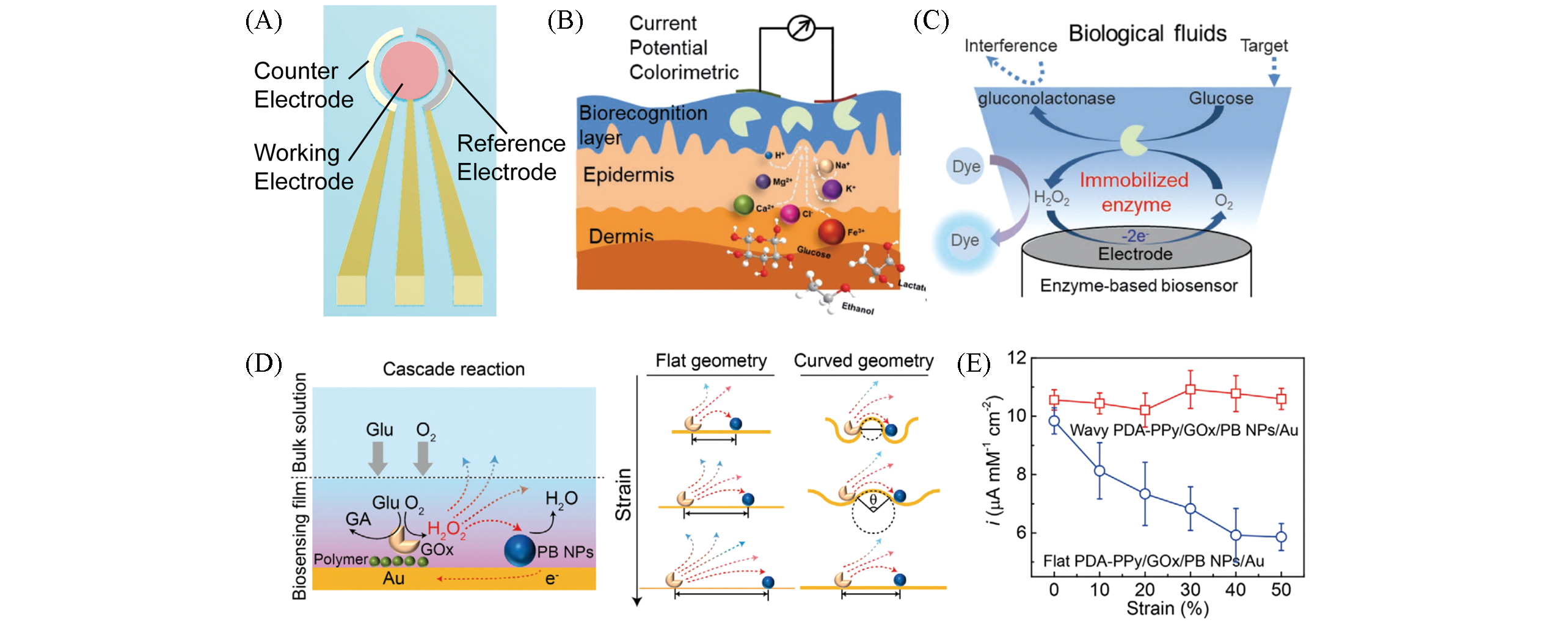
Fig.2 Electrochemical sensing based on enzymatic amperometry and its application in flexible electronics(A) Three electrode detection system; (B) enzyme catalyzed electrochemical sensors; (C) the mechanism of glucose sensor based on glucose oxidase and dye as redox mediator[41]. Copyright 2020, Wiley-VCH; (D) diffusion of reaction intermediates in flexible chemical sensors for flat and curved geometries; (E) stable electrical currents under strain for curved sensors, compared to obvious decrease for conventional flat sensors[56]. Copyright 2020, Wiley-VCH.
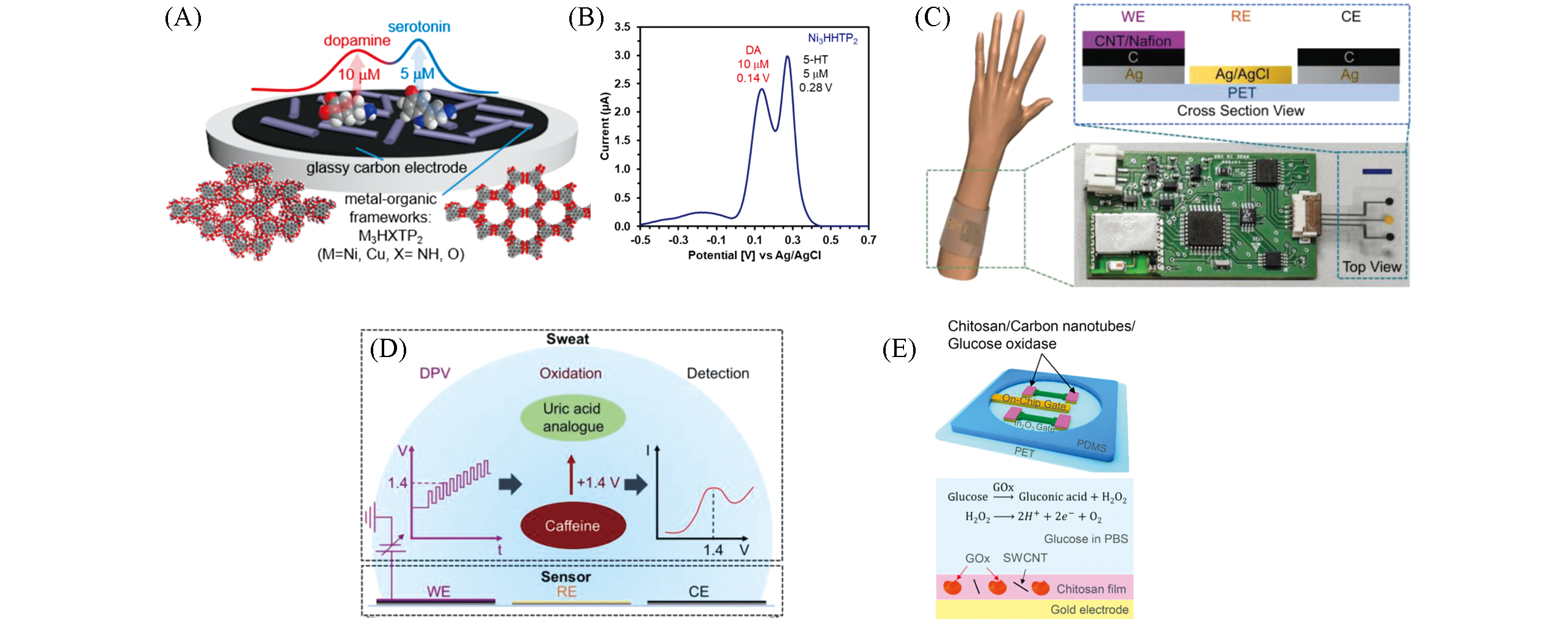
Fig.3 Flexible electrochemical sensing based on voltammetry and field effect transistor(A) Voltammetric sensing of neurochemicals based on conductive MOF modified electrodes; (B) simultaneous detection of dopamine and serotonin[63]. Copyright 2020, American Chemical Society; (C) wearable caffeine sensing device and its electrode structures; (D) mechanism of caffeine detection via differential pulse voltammetry[64]. Copyright 2018, Wiley-VCH; (E) a flexible glucose sensor based on field effect transistor[68]. Copyright 2018, American Chemical Society.
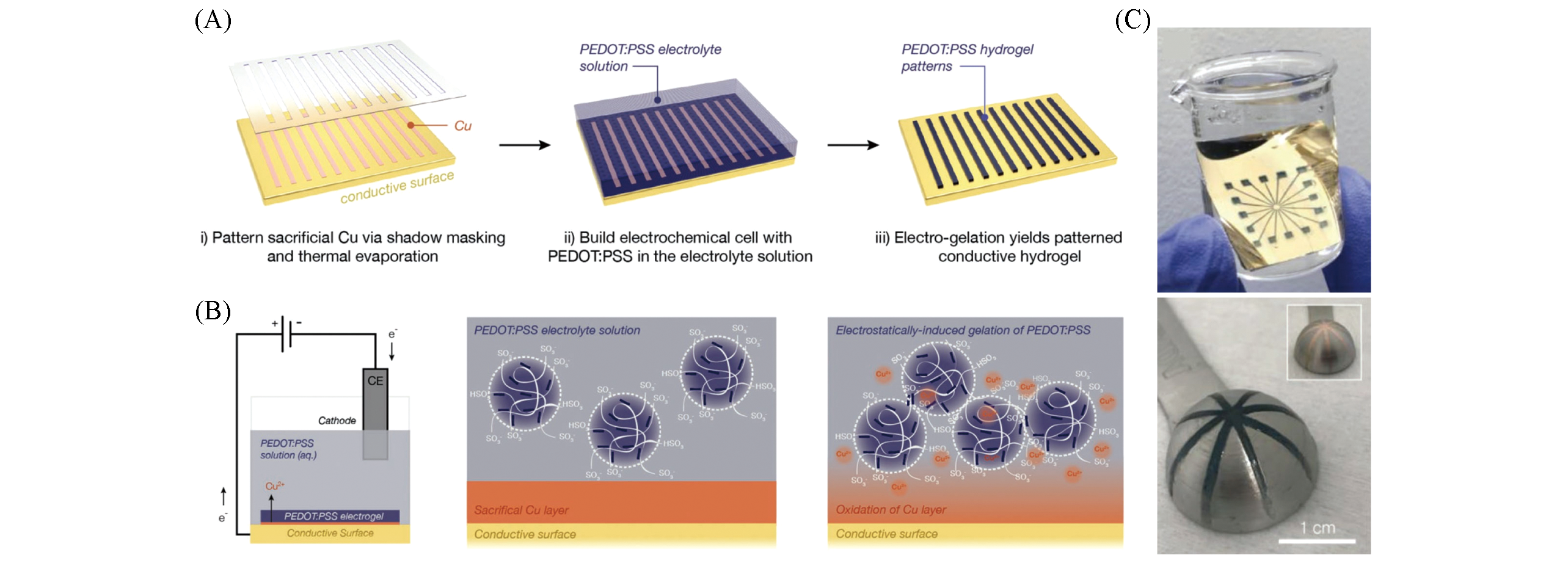
Fig.5 On surface electrochemical fabrication of flexible devices[74](A) Electro-gelation of PEDOT∶PSS conductive hydrogel on Cu pattern; (B) mechanism of electro-oxidation of Cu and subsequent PEDOT∶PSS gelation; (C) patterned conductive hydrogel on gold(up) and PDMS(down) substrates. Copyright 2019, Wiley-VCH.
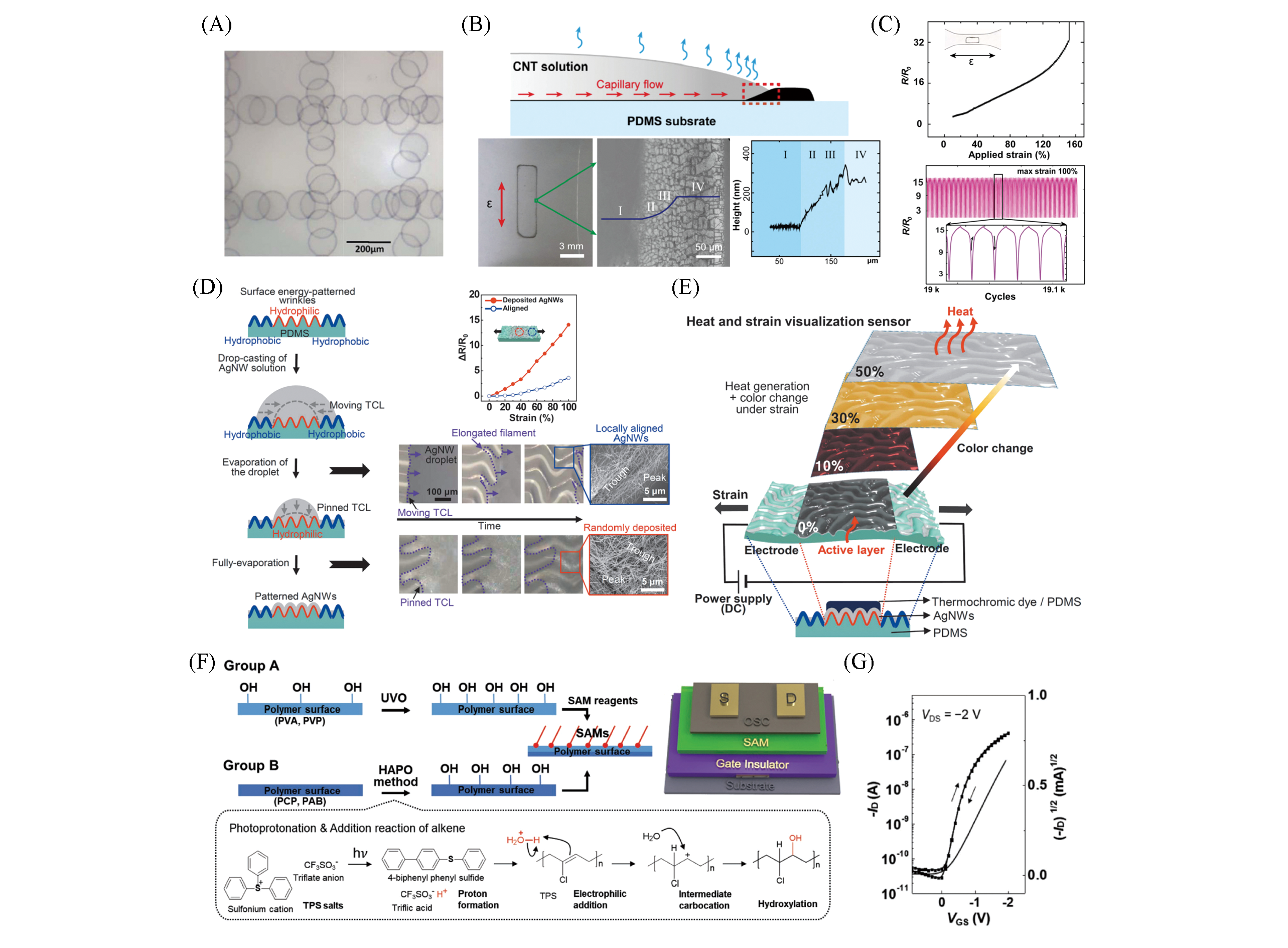
Fig.6 Tuning surface properties to assist the fabrication of flexible electronics via surface modification(A) Conductive network through printing CNT coffee rings[80]. Copyright 2014, Royal Society of Chemistry; (B) plasma assisted spatially controlled gradient pinning of CNT to fabricate strain sensors; (C) the stretchability, sensitivity, and stability of the strain sensors[79]. Copyright 2015, Wiley-VCH; (D) surface hydrophobicity assisted patterning of different functions from same conductive material; (E) heat and strain visualization under constant electric current[81]. Open access; (F) surface modification of gate insulator polymers by heat-assisted photo-acidic oxidation(HAPO) in flexible OFET; (G) performance of fabricated flexible OFET via HAPO method[84]. Copyright 2019, Wiley-VCH.
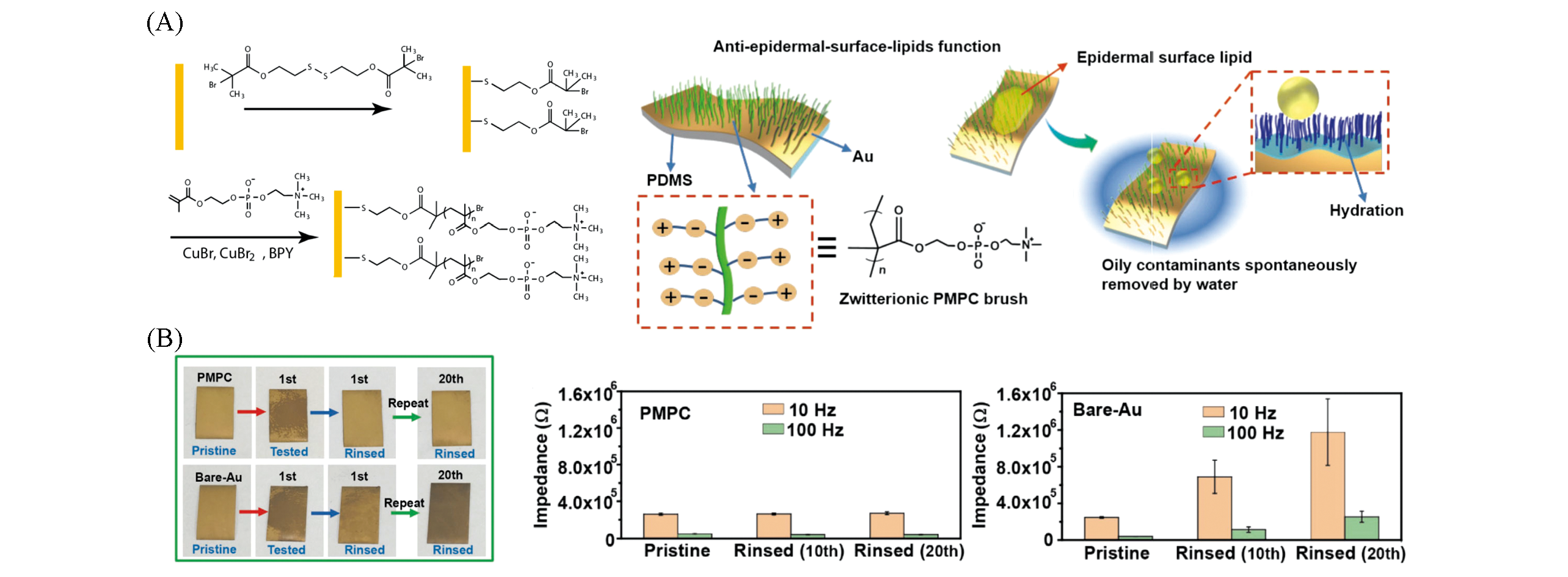
Fig.7 Covalent modification on surfaces of flexible electronics for enhancing performances[91](A) Modification of electrode surface with zwitterionic polymers PMPC to realize anti-epidermal-surface-lipids functions; (B) the stability of PMPC modified electrodes toward contamination-cleaning cycle, their electrical properties stayed stable, compared to the increased resistance of unmodified electrodes. Copyright 2020, Wiley-VCH.
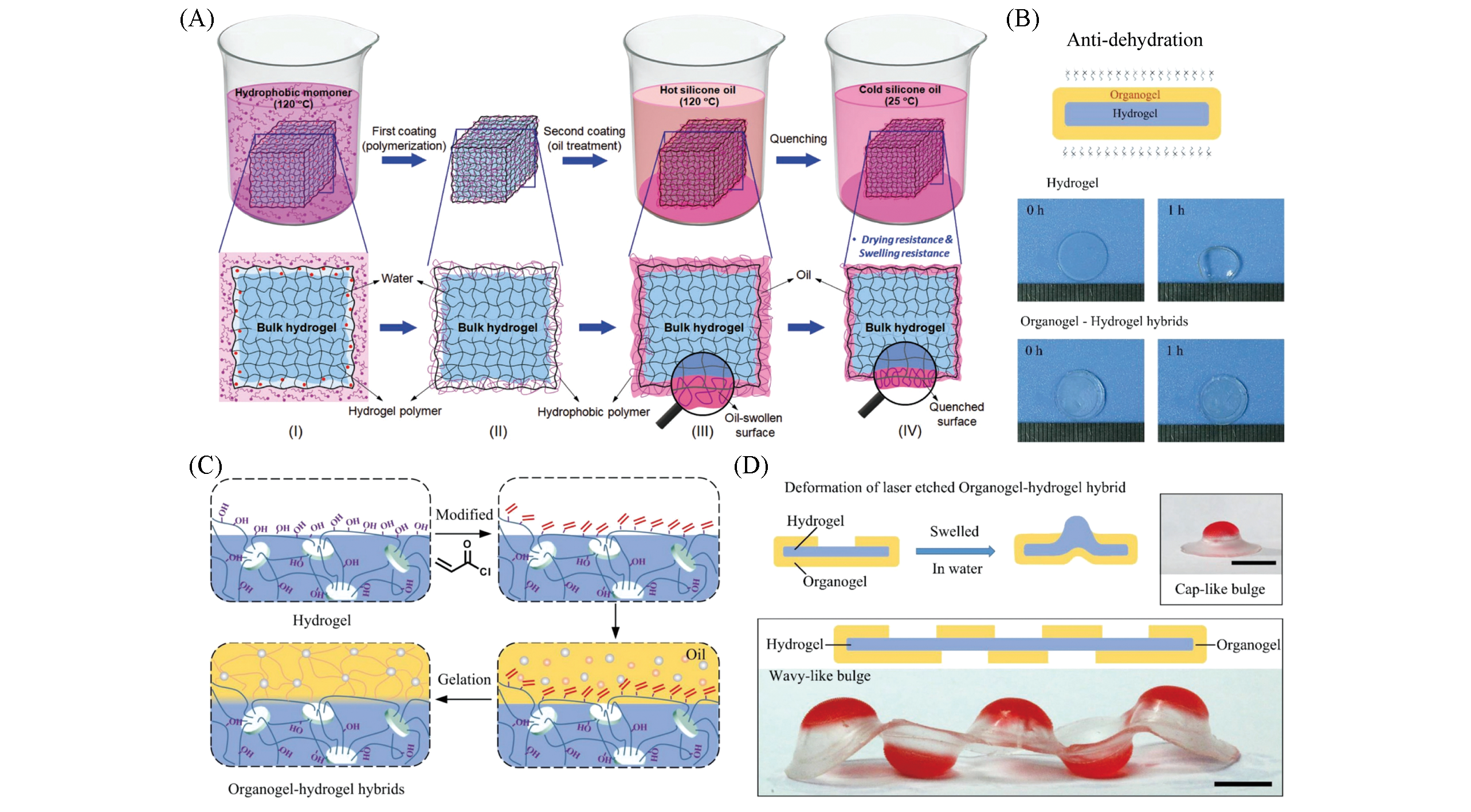
Fig.8 Integrating organogel layers on surface of hydrogels for protection and functionalization(A) Hydrogel embedded initiator induced surface polymerization of organogel networks and subsequent formation of organogel protection layer[110]. Open access; (B) anti-dehydration performance of organogel protected hydrogel; (C) co-polymerization of surface grafted monomer resulted in covalent linkage between hydrogel and organogel; (D) solvent triggered actuation and shape change of laser etched hydrogel-organogel hybrids[111]. Copyright 2018, Wiley-VCH.
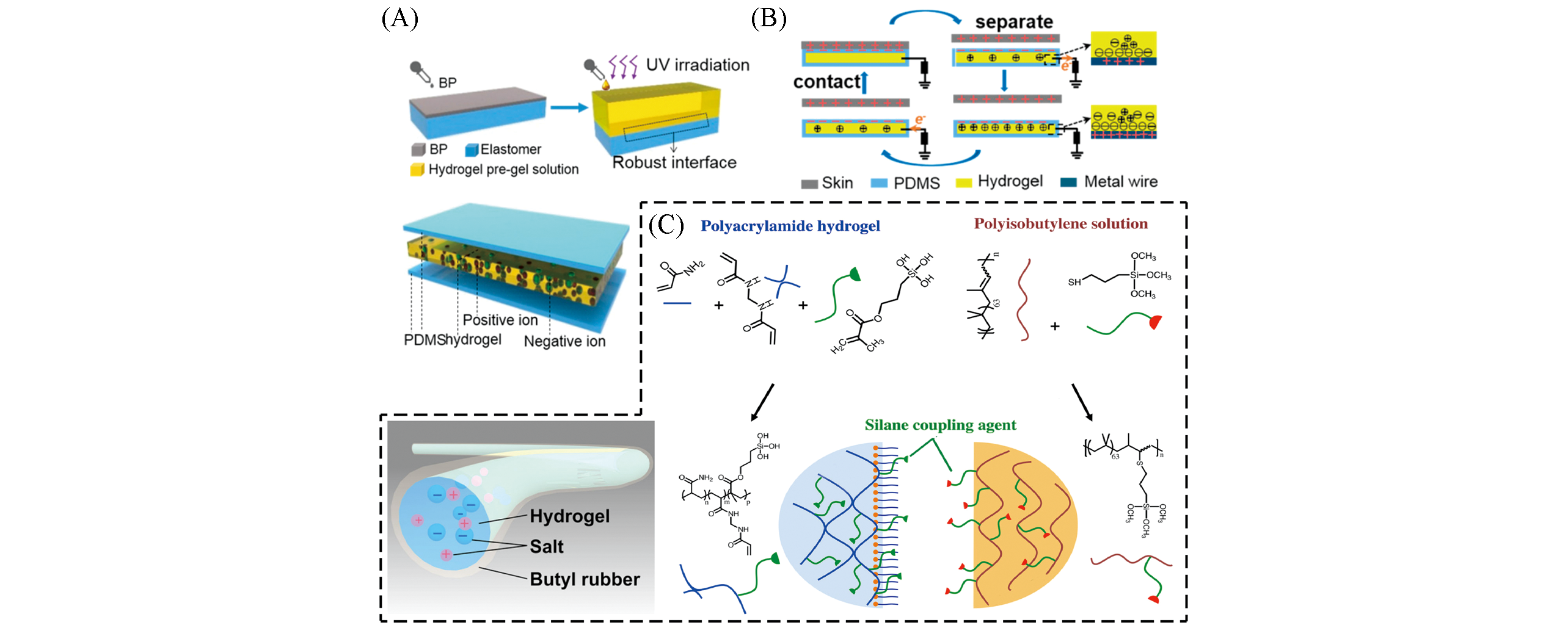
Fig.9 Covalently linking elastomers with hydrogels to realize gel protection and functionalization(A) Bonding between hydrogel and protective elastomer layer through surface initiated polymerization; (B) mechanism of elastomer covered hydrogels to function as triboelectric-nanogenerators[112]. Copyright 2018, American Chemical Society; (C) direct covalent linkage between hydrogels and protective elastomers to produce water-washable stretchable conductor fibers[113]. Copyright 2017, American Chemical Society.
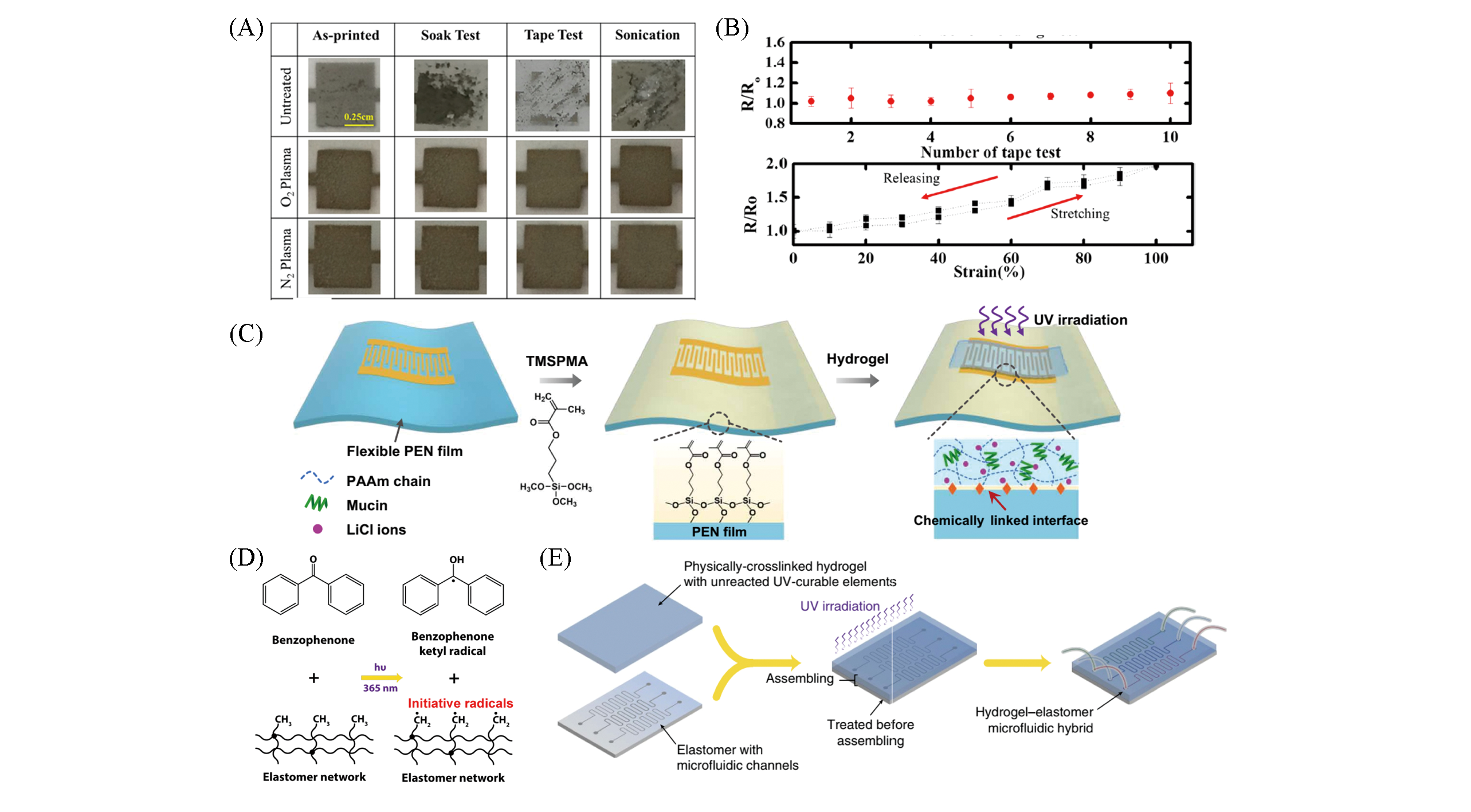
Fig.10 Covalent bond linking between different functional layers in flexible electronics(A) The stable covalent binding of epoxy containing silver paste on plasma treated elastomer surface; (B) stability and mechanoelectrical performance of covalently linked silver paste-elastomer[125]. Copyright 2016, American Chemical Society; (C) covalent linkage between functional hydrogel layer and elastomer substrate to avoid delamination caused fake signals[127]. Open access; (D) the initiation mechanism of elastomer surface soaked benzophenone under UV light; (E) UV induced covalent linkage between physically crosslinked pre-hydrogel and elastomers to form micro channels[128]. Open access.
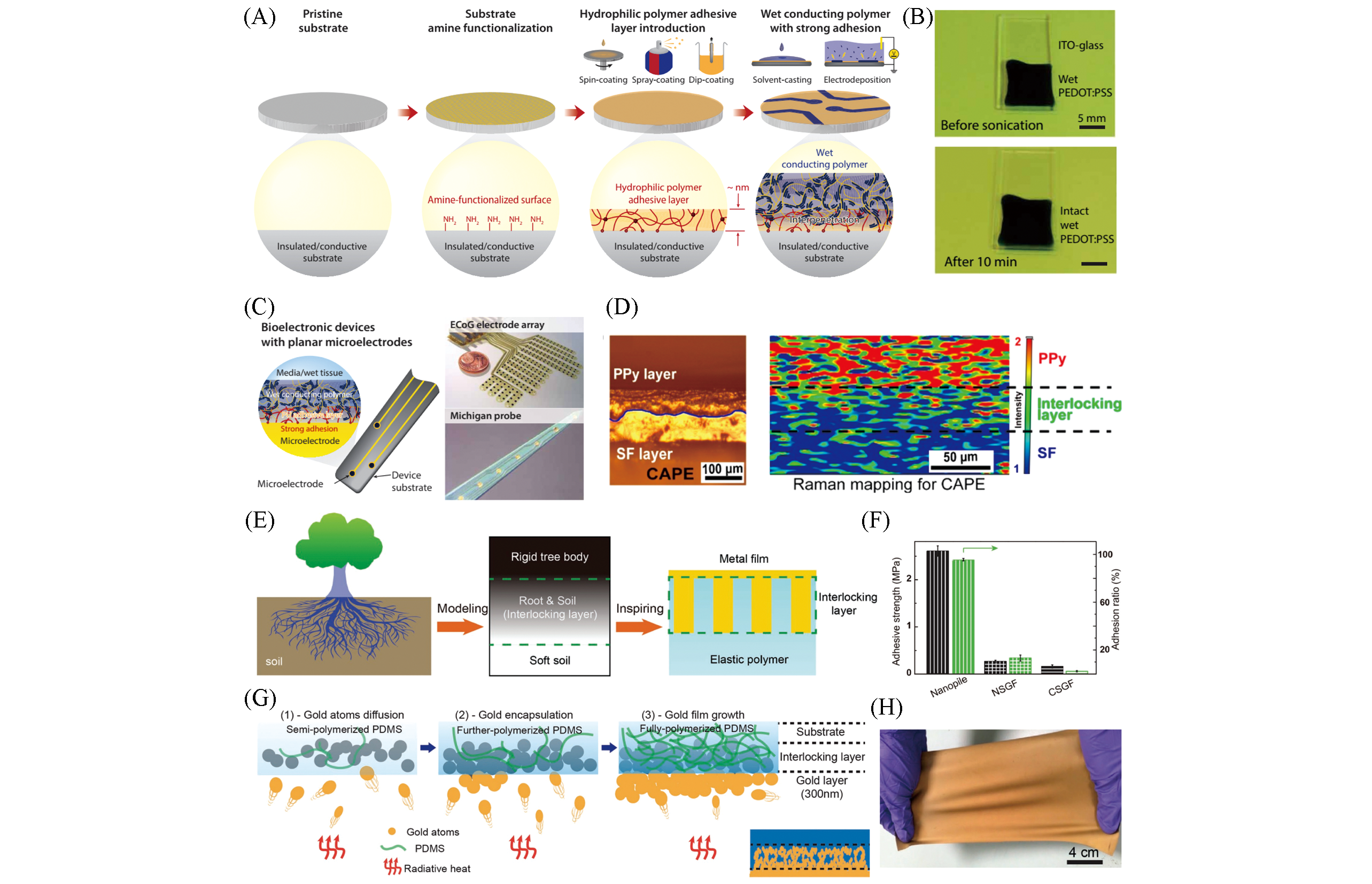
Fig.11 Surface chemistry assisted physical interlocking enabled strong interlayer binding in flexible electronics(A) Stable adhesion of wet conducting polymers on solid substrates via a hydrophilic polymer nanolayer; (B) stable adhesion endu-ring 10 min sonication in water; (C) wet conducting polymer modified micro-electrode arrays[132]. Open access; (D) physical interlocking between silk fibroin adhesive layer and polypyrrole conductive layer through interfacial polymerization[133]. Copyright 2020, American Chemical Society; (E) tree root inspired nanopile interlocking structure between gold and elastomer substrate; (F) the high adhesion between gold and substrate of nanopile interlocking[134]. Copyright 2016, Wiley-VCH; (G) thermal-radiation-assis-ted gold encapsulation in semi-polymerized elastomer substrate to produce interlocked structures; (H) scalable fabrication through thermal-radiation-assisted gold encapsulation[135]. Copyright 2019, Wiley-VCH.
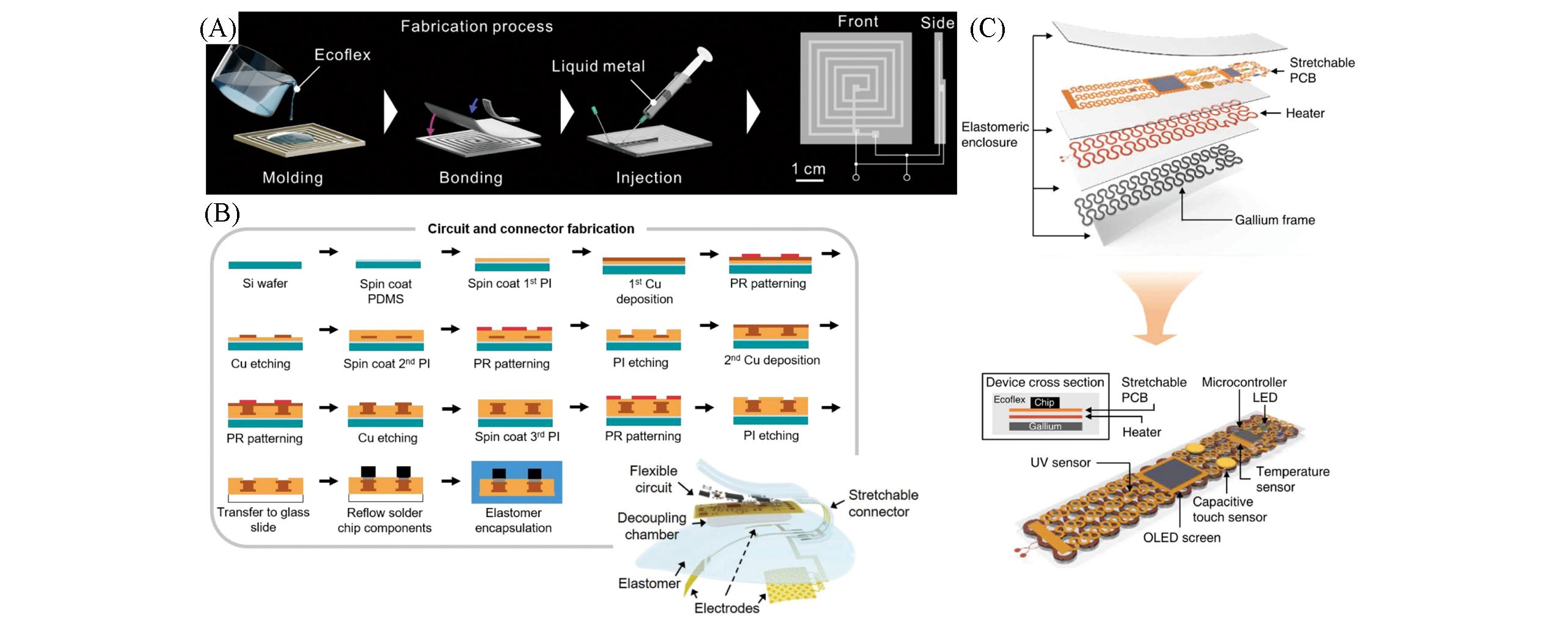
Fig.12 Encapsulation and integration of entire flexible devices(A) Fabrication process of simple flexible devices through pre-molding and metal injection[136]. Open access; (B) fabrication of complex flexible devices through stepwise curing, pattering, binding, and encapsulation[137]. Open access; (C) multi-layer yet electrically insulated flexible device[138]. Open access.
| 28 | Yu Y., Nyein H. Y. Y., Gao W., Javey A., Adv. Mater., 2020, 32(15), 1902083 |
| 29 | Yang Y., Gao W., Chem. Soc. Rev., 2019, 48(6), 1465—1491 |
| 30 | Kim J., Jeerapan I., Sempionatto J. R., Barfidokht A., Mishra R. K., Campbell A. S., Hubble L. J., Wang J., Acc. Chem. Res., 2018, 51(11), 2820—2828 |
| 31 | Bariya M., Nyein H. Y. Y., Javey A., Nat. Electron., 2018, 1(3), 160—171 |
| 32 | Choi J., Bandodkar A. J., Reeder J. T., Ray T. R., Turnquist A., Kim S. B., Nyberg N., Hourlier⁃Fargette A., Model J. B., Aranyosi A. J., Xu S., Ghaffari R., Rogers J. A., ACS Sens., 2019, 4(2), 379—388 |
| 33 | Reeder J. T., Choi J., Xue Y., Gutruf P., Hanson J., Liu M., Ray T., Bandodkar A. J., Avila R., Xia W., Krishnan S., Xu S., Barnes K., Pahnke M., Ghaffari R., Huang Y., Rogers J. A., Sci. Adv., 2019, 5(1), eaau6356 |
| 34 | Zhang Y., Guo H., Kim S. B., Wu Y., Ostojich D., Park S. H., Wang X., Weng Z., Li R., Bandodkar A. J., Sekine Y., Choi J., Xu S., Quaggin S., Ghaffari R., Rogers J. A., Lab. Chip., 2019, 19(9), 1545—1555 |
| 35 | Harvey D., Anal. Bioanal. Chem., 2011, 399(1), 149—152 |
| 36 | Li X. G., Feng H., Huang M. R., Gu G. L., Moloney M. G., Anal. Chem., 2012, 84(1), 134—140 |
| 37 | Gao W., Emaminejad S., Nyein H. Y. Y., Challa S., Chen K., Peck A., Fahad H. M., Ota H., Shiraki H., Kiriya D., Lien D. H., Brooks G. A., Davis R. W., Javey A., Nature, 2016, 529(7587), 509—514 |
| 38 | Rogers K. R., Mol. Biotechnol., 2000, 14(2), 109—130 |
| 39 | Mannoor M. S., Tao H., Clayton J. D., Sengupta A., Kaplan D. L., Naik R. R., Verma N., Omenetto F. G., McAlpine M. C., Nat. Commun., 2012, 3, 763 |
| 40 | Yang Y., Yang X., Zou X., Wu S., Wan D., Cao A., Liao L., Yuan Q., Duan X., Adv. Funct. Mater., 2017, 27(19), 1604096 |
| 41 | Wang T., Wang M., Yang L., Li Z., Loh X. J., Chen X., Adv. Mater., 2020, 32(8), 1905522 |
| 42 | Rocchitta G., Spanu A., Babudieri S., Latte G., Madeddu G., Galleri G., Nuvoli S., Bagella P., Demartis M. I., Fiore V., Manetti R., Serra P. A., Sensors, 2016, 16(6), 780 |
| 43 | Karyakin A. A., Gitelmacher O. V., Karyakina E. E., Anal. Chem., 2002, 67(14), 2419—2423 |
| 44 | Njagi J. I., Kagwanja S. M., The Interface in Biosensing: Improving Selectivity and SensitivityinInterfaces and Interphases in Analytical Chemistry, ACS Symposium Series, Vol. 1062,Eds: Helburn R., Vitha M. F., American Chemical Society, Washington DC, 2011 |
| 45 | Cash K. J., Clark H. A., Trends Mol. Med., 2010, 16(12), 584—593 |
| 46 | Wahab H. A., Salama A. A., El Saeid A. A., Willander M., Nur O., Battisha I. K., Results Phys., 2018, 9, 809—814 |
| 47 | Arakawa T., Kuroki Y., Nitta H., Chouhan P., Toma K., Sawada S., Takeuchi S., Sekita T., Akiyoshi K., Minakuchi S., Mitsubayashi K., Biosens. Bioelectron., 2016, 84, 106—111 |
| 48 | Liao Y. T., Yao H., Lingley A., Parviz B., Otis B. P., IEEE J. Solid⁃State Circuits, 2012, 47(1), 335—344 |
| 49 | Hennig A., Lauko J., Grabmaier A., Wilson C., Proc. Eng., 2014, 87, 66—69 |
| 50 | Bandodkar A. J., Jia W., Yardimci C., Wang X., Ramirez J., Wang J., Anal. Chem., 2015, 87(1), 394—398 |
| 51 | Lee H., Choi T. K., Lee Y. B., Cho H. R., Ghaffari R., Wang L., Choi H. J., Chung T. D., Lu N., Hyeon T., Choi S. H., Kim D. H., Nat. Nanotechnol., 2016, 11(6), 566—572 |
| 52 | Jia W., Bandodkar A. J., Valdes⁃Ramirez G., Windmiller J. R., Yang Z., Ramirez J., Chan G., Wang J., Anal. Chem., 2013, 85(14), 6553—6560 |
| 53 | Roy Choudhury S., Umasankar Y., Jaller J., Herskovitz I., Mervis J., Darwin E., Hirt P. A., Borda L. J., Lev⁃Tov H. A., Kirsner R., Bhansali S., J. Electrochem. Soc., 2018, 165(8), B3168—B3175 |
| 54 | Kim J., Jeerapan I., Imani S., Cho T. N., Bandodkar A., Cinti S., Mercier P. P., Wang J., ACS Sens., 2016, 1(8), 1011—1019 |
| 55 | Kim J., Imani S., de Araujo W. R., Warchall J., Valdes⁃Ramirez G., Paixao T. R., Mercier P. P., Wang J., Biosens. Bioelectron., 2015, 74, 1061—1068 |
| 56 | Wang T., Lei Q. L., Wang M., Deng G., Yang L., Liu X., Li C., Wang Q., Liu Z., Wang J., Cui Z., Utama K. G., Ni R., Chen X., Adv. Mater., 2020, 32(22), 2000991 |
| 57 | Gupta V. K., Jain R., Radhapyari K., Jadon N., Agarwal S., Anal. Biochem., 2011, 408(2), 179—196 |
| 58 | Day J. J., Roitman M. F., Wightman R. M., Carelli R. M., Nat. Neurosci., 2007, 10(8), 1020—1028 |
| 59 | Robinson D. L., Hermans A., Seipel A. T., Wightman R. M., Chem. Rev., 2008, 108(7), 2554—2584 |
| 60 | Aikens D. A., J. Chem. Educ., 1983, 60(1), A25 |
| 61 | Thévenot D. R., Toth K., Durst R. A., Wilson G. S., Anal. Lett., 2007, 34(5), 635—659 |
| 62 | McCreery R. L., Chem. Rev., 2008, 108(7), 2646—2687 |
| 63 | Ko M., Mendecki L., Eagleton A. M., Durbin C. G., Stolz R. M., Meng Z., Mirica K. A., J. Am. Chem. Soc., 2020, 142(27), 11717—11733 |
| 64 | Tai L. C., Gao W., Chao M., Bariya M., Ngo Q. P., Shahpar Z., Nyein H. Y. Y., Park H., Sun J., Jung Y., Wu E., Fahad H. M., Lien D. H., Ota H., Cho G., Javey A., Adv. Mater., 2018, 30(23), 1707442 |
| 65 | Wang N., Yang A., Fu Y., Li Y., Yan F., Acc. Chem. Res., 2019, 52(2), 277—287 |
| 66 | Lee M. Y., Lee H. R., Park C. H., Han S. G., Oh J. H., Acc. Chem. Res., 2018, 51(11), 2829—2838 |
| 67 | Rivnay J., Inal S., Salleo A., Owens R. M., Berggren M., Malliaras G. G., Nat. Rev. Mater., 2018, 3(2), 17086 |
| 68 | Liu Q., Liu Y., Wu F., Cao X., Li Z., Alharbi M., Abbas A. N., Amer M. R., Zhou C., ACS Nano, 2018, 12(2), 1170—1178 |
| 69 | Li J., Sun C. L., An P., Liu X., Dong R., Sun J., Zhang X., Xie Y., Qin C., Zheng W., Zhang H. L., Jiang X., J. Am. Chem. Soc., 2019, 141(22), 8816—8824 |
| 70 | Shi G., Jin S., Xue G., Li C., Science, 1995, 267(5200), 994—996 |
| 71 | Sekine S., Ido Y., Miyake T., Nagamine K., Nishizawa M., J. Am. Chem. Soc., 2010, 132(38), 13174—13175 |
| 72 | Bodart C., Rossetti N., Hagler J., Chevreau P., Chhin D., Soavi F., Schougaard S. B., Amzica F., Cicoira F., ACS Appl. Mater. Interfaces, 2019, 11(19), 17226—17233 |
| 73 | Wang J., Lu T., Yang M., Sun D., Xia Y., Wang T., Sci. Adv., 2019, 5(3), eaau8769 |
| 74 | Feig V. R., Tran H., Lee M., Liu K., Huang Z., Beker L., Mackanic D. G., Bao Z., Adv. Mater., 2019, 31(39), 1902869 |
| 75 | Liston E. M., J. Adhes., 1989, 30(1—4), 199—218 |
| 76 | Owen M. J., Smith P. J., J. Adhes. Sci. Technol., 1994, 8(10), 1063—1075 |
| 77 | Gonzalez Ⅱ E., Barankin M. D., Guschl P. C., Hicks R. F., Langmuir, 2008, 24(21), 12636—12643 |
| 78 | Zhang Y., Rawat R. S., Fan H. J., Small Methods, 2017, 1(9), 1700164 |
| 79 | Liu Z., Qi D., Guo P., Liu Y., Zhu B., Yang H., Liu Y., Li B., Zhang C., Yu J., Liedberg B., Chen X., Adv. Mater., 2015, 27(40), 6230—6237 |
| 80 | Shimoni A., Azoubel S., Magdassi S., Nanoscale, 2014, 6(19), 11084—11089 |
| 81 | Lee G., Bae G. Y., Son J. H., Lee S., Kim S. W., Kim D., Lee S. G., Cho K., Adv. Sci., 2020, 7, 2001184 |
| 82 | Richards T., Bird M., Sirringhaus H., J. Chem. Phys., 2008, 128(23), 234905 |
| 83 | Nikolka M., Nasrallah I., Rose B., Ravva M. K., Broch K., Sadhanala A., Harkin D., Charmet J., Hurhangee M., Brown A., Illig S., Too P., Jongman J., McCulloch I., Bredas J. L., Sirringhaus H., Nat. Mater., 2017, 16(3), 356—362 |
| 84 | Kim J., Kang B., Cho K., Adv. Funct. Mater., 2019, 29(11), 1806030 |
| 85 | Jeong J. W., Yeo W. H., Akhtar A., Norton J. J., Kwack Y. J., Li S., Jung S. Y., Su Y., Lee W., Xia J., Cheng H., Huang Y., Choi W. S., Bretl T., Rogers J. A., Adv. Mater., 2013, 25(47), 6839—6846 |
| 86 | Miyamoto A., Lee S., Cooray N. F., Lee S., Mori M., Matsuhisa N., Jin H., Yoda L., Yokota T., Itoh A., Sekino M., Kawasaki H., Ebihara T., Amagai M., Someya T., Nat. Nanotechnol., 2017, 12(9), 907—913 |
| 87 | Ferrari L. M., Sudha S., Tarantino S., Esposti R., Bolzoni F., Cavallari P., Cipriani C., Mattoli V., Greco F., Adv. Sci., 2018, 5(3), 1700771 |
| 88 | Nawrocki R. A., Jin H., Lee S., Yokota T., Sekino M., Someya T., Adv. Funct. Mater., 2018, 28(36), 1803279 |
| 89 | Jiang Z., Nayeem M. O. G., Fukuda K., Ding S., Jin H., Yokota T., Inoue D., Hashizume D., Someya T., Adv. Mater., 2019, 31(37), 1903446 |
| 90 | Zhang Y., Tao T. H., Adv. Mater., 2019, 31(49), 1905767 |
| 91 | He K., Liu Z., Wan C., Jiang Y., Wang T., Wang M., Zhang F., Liu Y., Pan L., Xiao M., Yang H., Chen X., Adv. Mater., 2020, 32(24), 2001130 |
| 92 | Hensleigh R., Cui H., Xu Z., Massman J., Yao D., Berrigan J., Zheng X., Nat. Electron., 2020, 3(4), 216—224 |
| 93 | Van Vlierberghe S., Dubruel P., Schacht E., Biomacromolecules, 2011, 12(5), 1387—1408 |
| 94 | Ullah F., Othman M. B., Javed F., Ahmad Z., Md Akil H., Mater. Sci. Eng. C⁃Mater. Biol. Appl., 2015, 57, 414—433 |
| 95 | Taylor D. L., In Het Panhuis M., Adv. Mater., 2016, 28(41), 9060—9093 |
| 96 | Culver H. R., Clegg J. R., Peppas N. A., Acc. Chem. Res., 2017, 50(2), 170—178 |
| 97 | Lowenberg C., Balk M., Wischke C., Behl M., Lendlein A., Acc. Chem. Res., 2017, 50(4), 723—732 |
| 98 | Li S., Dong S., Xu W., Tu S., Yan L., Zhao C., Ding J., Chen X., Adv. Sci., 2018, 5(5), 1700527 |
| 99 | Sheng H., Xue B., Qin M., Wang W., Cao Y., Chem. J. Chinese Universities, 2020, 41(6), 1194—1207(盛卉, 薛斌, 秦猛, 王炜, 曹毅. 高等学校化学学报, 2020, 41(6), 1194—1207) |
| 100 | Yang C., Suo Z., Nat. Rev. Mater., 2018, 3(6), 125—142 |
| 101 | Yuk H., Lu B., Zhao X., Chem. Soc. Rev., 2019, 48(6), 1642—1667 |
| 102 | Shintake J., Cacucciolo V., Floreano D., Shea H., Adv. Mater., 2018, 30(29), 1707035 |
| 103 | Zhang W., Feng P., Chen J., Sun Z., Zhao B., Prog. Polym. Sci., 2019, 88, 220—240 |
| 104 | Liu X., Liu J., Lin S., Zhao X., Mater. Today, 2020, 36, 102—124 |
| 105 | Zhou D., Chen F., Handschuh⁃Wang S., Gan T., Zhou X., Zhou X., ChemPhysChem, 2019, 20(17), 2139—2154 |
| 106 | Duan P., Li Y., Jiang J., Wang T., Liu M., Sci. China Chem., 2011, 54(7), 1051—1063 |
| 107 | Gao C., Wang L., Lin Y., Li J., Liu Y., Li X., Feng S., Zheng Y., Adv. Funct. Mater., 2018, 28(35), 1803072 |
| 108 | Yu Y., Jin B., Jamil M. I., Cheng D., Zhang Q., Zhan X., Chen F., ACS Appl. Mater. Interfaces, 2019, 11(13), 12838—12845 |
| 109 | Zhang H., Niu W., Zhang S., ACS Appl. Mater. Interfaces, 2018, 10(38), 32640—32648 |
| 110 | Mredha M. T. I., Le H. H., Cui J., Jeon I., Adv. Sci., 2020, 7(6), 1903145 |
| 1 | De Talhouet H., Webster J. G., Physiol. Meas., 1996, 17(2), 81—93 |
| 2 | Kim D. H., Lu N., Ma R., Kim Y. S., Kim R. H., Wang S., Wu J., Won S. M., Tao H., Islam A., Yu K. J., Kim T. I., Chowdhury R., Ying M., Xu L., Li M., Chung H. J., Keum H., McCormick M., Liu P., Zhang Y. W., Omenetto F. G., Huang Y., Coleman T., Rogers J. A., Science, 2011, 333(6044), 838—843 |
| 111 | Zhao T., Wang G., Hao D., Chen L., Liu K., Liu M., Adv. Funct. Mater., 2018, 28(49), 1800793 |
| 112 | Liu T., Liu M., Dou S., Sun J., Cong Z., Jiang C., Du C., Pu X., Hu W., Wang Z. L., ACS Nano, 2018, 12(3), 2818—2826 |
| 3 | Benight S. J., Wang C., Tok J. B. H., Bao Z., Prog. Polym. Sci., 2013, 38(12), 1961—1977 |
| 4 | Park S., Vosguerichian M., Bao Z., Nanoscale, 2013, 5(5), 1727—1752 |
| 5 | Liu Y., Pharr M., Salvatore G. A., ACS Nano, 2017, 11(10), 9614—9635 |
| 6 | Qu D. W., Li X., Chen G. M., Chem. J. Chinese Universities, 2019, 40(4), 617—623(曲大伟, 李昕, 陈光明. 高等学校化学学报, 2019, 40(4), 617—623) |
| 7 | Gao N. W., Ma Q., He Y. L., Wang Y. P., Chem. J. Chinese Universities, 2020, 41(5), 901—908(高乃伟, 马强, 贺泳霖, 王亚培. 高等学校化学学报, 2020, 41(5), 901—908) |
| 113 | Le Floch P., Yao X., Liu Q., Wang Z., Nian G., Sun Y., Jia L., Suo Z., ACS Appl. Mater. Interfaces, 2017, 9(30), 25542—25552 |
| 114 | Timko B. P., Cohen⁃Karni T., Yu G., Qing Q., Tian B., Lieber C. M., Nano Lett., 2009, 9(2), 914—918 |
| 115 | Fu T. M., Hong G., Zhou T., Schuhmann T. G., Viveros R. D., Lieber C. M., Nat. Methods, 2016, 13(10), 875—882 |
| 116 | Fang H., Yu K. J., Gloschat C., Yang Z., Chiang C. H., Zhao J., Won S. M., Xu S., Trumpis M., Zhong Y., Song E., Han S. W., Xue Y., Xu D., Cauwenberghs G., Kay M., Huang Y., Viventi J., Efimov I. R., Rogers J. A., Nat. Biomed. Eng., 2017, 1, 0038 |
| 117 | Shi B., Li Z., Fan Y., Adv. Mater., 2018, 30(44), 1801511 |
| 118 | Yan X., Liu Z., Zhang Q., Lopez J., Wang H., Wu H. C., Niu S., Yan H., Wang S., Lei T., Li J., Qi D., Huang P., Huang J., Zhang Y., Wang Y., Li G., Tok J. B., Chen X., Bao Z., J. Am. Chem. Soc., 2018, 140(15), 5280—5289 |
| 119 | Yuan J., Liu M., J. Am. Chem. Soc., 2003, 125(17), 5051—5056 |
| 120 | Huang X., Li C., Jiang S., Wang X., Zhang B., Liu M., J. Am. Chem. Soc., 2004, 126(5), 1322—1323 |
| 121 | Shen Z., Jiang Y., Wang T., Liu M., J. Am. Chem. Soc., 2015, 137(51), 16109—16115 |
| 8 | Ma Y., Zhang Y., Cai S., Han Z., Liu X., Wang F., Cao Y., Wang Z., Li H., Chen Y., Feng X., Adv. Mater., 2020, 32(15), 1902062 |
| 9 | Lim H. R., Kim H. S., Qazi R., Kwon Y. T., Jeong J. W., Yeo W. H., Adv. Mater., 2020, 32(15), 1901924 |
| 122 | Deng M., Zhang L., Jiang Y., Liu M., Angew. Chem. Int. Ed., 2016, 55(48), 15062—15066 |
| 123 | Jiang H., Jiang Y., Han J., Zhang L., Liu M., Angew. Chem. Int. Ed., 2019, 58(3), 785—790 |
| 124 | Davoodi E., Montazerian H., Haghniaz R., Rashidi A., Ahadian S., Sheikhi A., Chen J., Khademhosseini A., Milani A. S., Hoorfar M., Toyserkani E., ACS Nano, 2020, 14(2), 1520—1532 |
| 10 | Lee Y., Lee T. W., Acc. Chem. Res., 2019, 52(4), 964—974 |
| 11 | Zhang M., Tang Z., Liu X., Van der Spiegel J., Nat. Electron., 2020, 3(4), 191—200 |
| 125 | Li C. Y., Liao Y. C., ACS Appl. Mater. Interfaces, 2016, 8(18), 11868—11874 |
| 126 | Yuk H., Zhang T., Lin S., Parada G. A., Zhao X., Nat. Mater., 2016, 15(2), 190—196 |
| 12 | Kong Z., Lu X. Y., Zhu Y., Jiang L., Chem. J. Chinese Universities, 2015, 36(4), 614—618(孔壮, 鹿现永, 朱英, 江雷. 高等学校化学学报, 2015, 36(4), 614—618) |
| 13 | Matsuhisa N., Chen X., Bao Z., Someya T., Chem. Soc. Rev., 2019, 48(11), 2946—2966 |
| 14 | Chen Z. H., Fang R., Li W., Guan J., Adv. Mater., 2019, 31(35), 1900756 |
| 15 | Wang B., Facchetti A., Adv. Mater., 2019, 31(28), 1901408 |
| 16 | Hao H. Y., Wang X., Shao Z. Q., Yang R. J., Chem. J. Chinese Universities, 2015, 36(9), 1838—1845(郝红英, 王茜, 邵自强, 杨荣杰. 高等学校化学学报, 2015, 36(9), 1838—1845) |
| 127 | Yeom J., Choe A., Lim S., Lee Y., Na S., Ko H., Sci. Adv., 2020, 6(23), eaba5785 |
| 128 | Yuk H., Zhang T., Parada G. A., Liu X., Zhao X., Nat. Commun., 2016, 7, 12028 |
| 17 | Dubal D. P., Chodankar N. R., Kim D. H., Gomez⁃Romero P., Chem. Soc. Rev., 2018, 47(6), 2065—2129 |
| 18 | Tao X., Acc. Chem. Res., 2019, 52(2), 307—315 |
| 19 | Li J., Zhao J., Rogers J. A., Acc. Chem. Res., 2019, 52(1), 53—62 |
| 129 | Liu X., Tang T. C., Tham E., Yuk H., Lin S., Lu T. K., Zhao X., Proc. Natl. Acad. Sci. USA, 2017, 114(9), 2200—2205 |
| 130 | Lu B., Yuk H., Lin S., Jian N., Qu K., Xu J., Zhao X., Nat. Commun., 2019, 10, 1043 |
| 20 | Chung H. U., Kim B. H., Lee J. Y., Lee J., Xie Z., Ibler E. M., Lee K., Banks A., Jeong J. Y., Kim J., Ogle C., Grande D., Yu Y., Jang H., Assem P., Ryu D., Kwak J. W., Namkoong M., Park J. B., Lee Y., Kim D. H., Ryu A., Jeong J., You K., Ji B., Liu Z., Huo Q., Feng X., Deng Y., Xu Y., Jang K. I., Kim J., Zhang Y., Ghaffari R., Rand C. M., Schau M., Hamvas A., Weese⁃Mayer D. E., Huang Y., Lee S. M., Lee C. H., Shanbhag N. R., Paller A. S., Xu S., Rogers J. A., Science, 2019, 363(6430), eaau0780 |
| 21 | Li T., Huang Z., Suo Z., Lacour S. P., Wagner S., Appl. Phys. Lett., 2004, 85(16), 3435—3437 |
| 131 | Fan X., Nie W., Tsai H., Wang N., Huang H., Cheng Y., Wen R., Ma L., Yan F., Xia Y., Adv. Sci., 2019, 6(19), 1900813 |
| 132 | Inoue A., Yuk H., Lu B., Zhao X., Sci. Adv., 2020, 6(12), eaay5394 |
| 22 | Choi S., Han S. I., Jung D., Hwang H. J., Lim C., Bae S., Park O. K., Tschabrunn C. M., Lee M., Bae S. Y., Yu J. W., Ryu J. H., Lee S. W., Park K., Kang P. M., Lee W. B., Nezafat R., Hyeon T., Kim D. H., Nat. Nanotechnol., 2018, 13(11), 1048—1056 |
| 23 | Zhang Y., Wang S., Li X., Fan J. A., Xu S., Song Y. M., Choi K. J., Yeo W. H., Lee W., Nazaar S. N., Lu B., Yin L., Hwang K. C., Rogers J. A., Huang Y., Adv. Funct. Mater., 2014, 24(14), 2028—2037 |
| 133 | Yang H., Ji S., Chaturvedi I., Xia H., Wang T., Chen G., Pan L., Wan C., Qi D., Ong Y. S., Chen X., ACS Materials Lett., 2020, 2(5), 478—484 |
| 134 | Liu Z., Wang X., Qi D., Xu C., Yu J., Liu Y., Jiang Y., Liedberg B., Chen X., Adv. Mater., 2017, 29(2), 1603382 |
| 24 | Xu S., Zhang Y., Jia L., Mathewson K. E., Jang K. I., Kim J., Fu H., Huang X., Chava P., Wang R., Bhole S., Wang L., Na Y. J., Guan Y., Flavin M., Han Z., Huang Y., Rogers J. A., Science, 2014, 344(6179), 70—74 |
| 25 | Lee W., Kobayashi S., Nagase M., Jimbo Y., Saito I., Inoue Y., Yambe T., Sekino M., Malliaras G. G., Yokota T., Tanaka M., Someya T., Sci. Adv., 2018, 4(10), eaau2426 |
| 135 | Liu Z., Wang H., Huang P., Huang J., Zhang Y., Wang Y., Yu M., Chen S., Qi D., Wang T., Jiang Y., Chen G., Hu G., Li W., Yu J., Luo Y., Loh X. J., Liedberg B., Li G., Chen X., Adv. Mater., 2019, 31(35), 1901360 |
| 136 | Mao G., Drack M., Karami⁃Mosammam M., Wirthl D., Stockinger T., Schwödiauer R., Kaltenbrunner M., Sci. Adv., 2020, 6(26), eabc0251 |
| 26 | Stauffer F., Thielen M., Sauter C., Chardonnens S., Bachmann S., Tybrandt K., Peters C., Hierold C., Voros J., Adv. Healthc. Mater., 2018, 7(7), 1700994 |
| 27 | Kim T., Park J., Sohn J., Cho D., Jeon S., ACS Nano, 2016, 10(4), 4770—4778 |
| 137 | Kim Y. S., Mahmood M., Lee Y., Kim N. K., Kwon S., Herbert R., Kim D., Cho H. C., Yeo W. H., Adv. Sci., 2019, 6(17), 1900939 |
| 138 | Byun S. H., Sim J. Y., Zhou Z., Lee J., Qazi R., Walicki M. C., Parker K. E., Haney M. P., Choi S. H., Shon A., Gereau G. B., Bilbily J., Li S., Liu Y., Yeo W. H., McCall J. G., Xiao J., Jeong J. W., Sci. Adv., 2019, 5(11), eaay0418 |
| 139 | Huang Z., Hao Y., Li Y., Hu H., Wang C., Nomoto A., Pan T., Gu Y., Chen Y., Zhang T., Li W., Lei Y., Kim N., Wang C., Zhang L., Ward J. W., Maralani A., Li X., Durstock M. F., Pisano A., Lin Y., Xu S., Nat. Electron., 2018, 1(8), 473—480 |
| [1] | 李玉龙, 谢发婷, 管燕, 刘嘉丽, 张贵群, 姚超, 杨通, 杨云慧, 胡蓉. 基于银离子与DNA相互作用的比率型电化学传感器用于银离子的检测[J]. 高等学校化学学报, 2022, 43(8): 20220202. |
| [2] | 魏闯宇, 陈艳丽, 姜建壮. 基于乙硫基取代的三层酞菁铕二聚体修饰ITO电极构筑电化学多巴胺和尿酸传感器[J]. 高等学校化学学报, 2022, 43(1): 20210582. |
| [3] | 吴杨仪, 陈建平, 艾益静, 汪庆祥, 高飞, 高凤. 2-(2-羟基-3-甲氧基苯基)-C60的合成及在花椰菜花叶病毒启动子DNA传感检测中的应用[J]. 高等学校化学学报, 2021, 42(6): 1754. |
| [4] | 颜范勇, 孙中慧, 庞纪平, 江英霞, 陈圆. 苯并噻嗪衍生物功能化的碳点用于检测银杏叶茶中的槲皮素[J]. 高等学校化学学报, 2020, 41(8): 1768. |
| [5] | 付可飞, 连惠婷, 魏晓峰, 孙向英, 刘斌. 环糊精基阻抗型传感器的制备及对L-半胱氨酸的识别[J]. 高等学校化学学报, 2020, 41(4): 706. |
| [6] | 张鑫宇, 王红, 方云, 樊晔. 共轭亚油酸修饰Fe3O4纳米颗粒的刺激响应性[J]. 高等学校化学学报, 2020, 41(11): 2519. |
| [7] | 李勃天,邵伟,肖达,周雪,董俊伟,唐黎明. 聚吡咯纳米线凝胶的模板制备及储能与电化学传感性能[J]. 高等学校化学学报, 2020, 41(1): 183. |
| [8] | 李敏, 孔慧芳, 郭志慧. 基于铜离子与DNA相互作用的铜离子检测[J]. 高等学校化学学报, 2016, 37(7): 1269. |
| [9] | 胡一平, 陕多亮, 卢小泉. 基于金属有机框架/卟啉/多壁碳纳米管构建的新型葡萄糖非酶传感器[J]. 高等学校化学学报, 2016, 37(6): 1082. |
| [10] | 孙辉, 于庆松, 杨彪, 许国志. 聚醚醚酮表面的亲水改性和胶原蛋白固定化[J]. 高等学校化学学报, 2016, 37(6): 1154. |
| [11] | 张燕, 郑晶, 王娟, 郭满栋. 盐酸阿霉素分子印迹传感器的制备及识别特性[J]. 高等学校化学学报, 2016, 37(5): 860. |
| [12] | 庄欠粉, 王勇, 倪永年. 聚脱氧腺苷酸/还原石墨烯纳米复合膜电化学传感器检测核黄素[J]. 高等学校化学学报, 2015, 36(9): 1674. |
| [13] | 朱刚兵, 裴元鹏, 陈煜轩, 易银辉, 孙恒, 吴向阳. 基于碳纳米管@氧化石墨烯纳米带核壳结构复合物的甲萘胺电化学传感研究[J]. 高等学校化学学报, 2015, 36(10): 1888. |
| [14] | 尚光远, 李明. 十六烷基膦酸表面修饰纳米镍粉及其复合材料的制备和性能[J]. 高等学校化学学报, 2014, 35(2): 427. |
| [15] | 周鼎, 徐晓薇, 刘敏, 张皓, 孙宏晨. 基于纳米晶晶格热胀冷缩的高灵敏度荧光纳米温度计[J]. 高等学校化学学报, 2014, 35(2): 205. |
| 阅读次数 | ||||||
|
全文 |
|
|||||
|
摘要 |
|
|||||
